# 6,行为型模式
# 6.11 解释器模式
# 6.11.1 概述
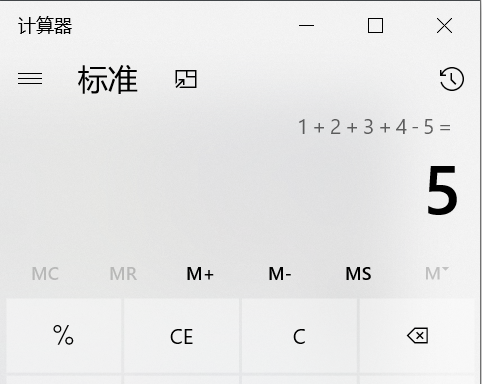
如上图,设计一个软件用来进行加减计算。我们第一想法就是使用工具类,提供对应的加法和减法的工具方法。
// 用于两个整数相加 | |
public static int add(int a,int b){ | |
return a + b; | |
} | |
// 用于两个整数相加 | |
public static int add(int a,int b,int c){ | |
return a + b + c; | |
} | |
// 用于 n 个整数相加 | |
public static int add(Integer ... arr) { | |
int sum = 0; | |
for (Integer i : arr) { | |
sum += i; | |
} | |
return sum; | |
} |
上面的形式比较单一、有限,如果形式变化非常多,这就不符合要求,因为加法和减法运算,两个运算符与数值可以有无限种组合方式。比如 1+2+3+4+5、1+2+3-4 等等。
显然,现在需要一种翻译识别机器,能够解析由数字以及 + - 符号构成的合法的运算序列。如果把运算符和数字都看作节点的话,能够逐个节点的进行读取解析运算,这就是解释器模式的思维。
定义:
给定一个语言,定义它的文法表示,并定义一个解释器,这个解释器使用该标识来解释语言中的句子。
在解释器模式中,我们需要将待解决的问题,提取出规则,抽象为一种 “语言”。比如加减法运算,规则为:由数值和 ± 符号组成的合法序列,“1+3-2” 就是这种语言的句子。
解释器就是要解析出来语句的含义。但是如何描述规则呢?
文法(语法)规则:
文法是用于描述语言的语法结构的形式规则。
expression ::= value | plus | minus
plus ::= expression ‘+’ expression
minus ::= expression ‘-’ expression
value ::= integer
注意: 这里的符号 “::=” 表示 “定义为” 的意思,竖线 | 表示或,左右的其中一个,引号内为字符本身,引号外为语法。
上面规则描述为 :
表达式可以是一个值,也可以是 plus 或者 minus 运算,而 plus 和 minus 又是由表达式结合运算符构成,值的类型为整型数。
抽象语法树:
在计算机科学中,抽象语法树(AbstractSyntaxTree,AST),或简称语法树(Syntax tree),是源代码语法结构的一种抽象表示。它以树状的形式表现编程语言的语法结构,树上的每个节点都表示源代码中的一种结构。
用树形来表示符合文法规则的句子。
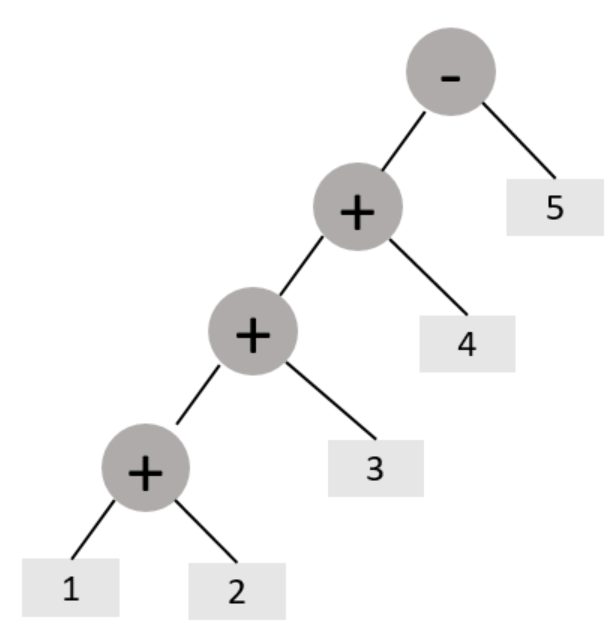
# 6.11.2 结构
解释器模式包含以下主要角色。
- 抽象表达式(Abstract Expression)角色:定义解释器的接口,约定解释器的解释操作,主要包含解释方法 interpret ()。
- 终结符表达式(Terminal Expression)角色:是抽象表达式的子类,用来实现文法中与终结符相关的操作,文法中的每一个终结符都有一个具体终结表达式与之相对应。
- 非终结符表达式(Nonterminal Expression)角色:也是抽象表达式的子类,用来实现文法中与非终结符相关的操作,文法中的每条规则都对应于一个非终结符表达式。
- 环境(Context)角色:通常包含各个解释器需要的数据或是公共的功能,一般用来传递被所有解释器共享的数据,后面的解释器可以从这里获取这些值。
- 客户端(Client):主要任务是将需要分析的句子或表达式转换成使用解释器对象描述的抽象语法树,然后调用解释器的解释方法,当然也可以通过环境角色间接访问解释器的解释方法。
# 6.11.3 案例实现
【例】设计实现加减法的软件
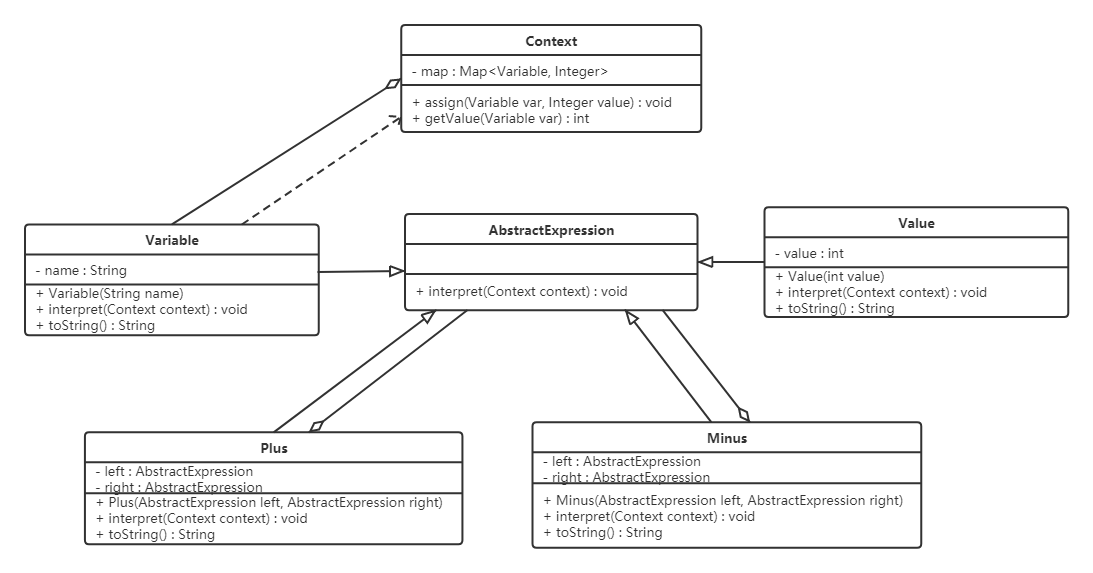
代码如下:
// 抽象角色 AbstractExpression | |
public abstract class AbstractExpression { | |
public abstract int interpret(Context context); | |
} | |
// 终结符表达式角色 | |
public class Value extends AbstractExpression { | |
private int value; | |
public Value(int value) { | |
this.value = value; | |
} | |
@Override | |
public int interpret(Context context) { | |
return value; | |
} | |
@Override | |
public String toString() { | |
return new Integer(value).toString(); | |
} | |
} | |
// 非终结符表达式角色 加法表达式 | |
public class Plus extends AbstractExpression { | |
private AbstractExpression left; | |
private AbstractExpression right; | |
public Plus(AbstractExpression left, AbstractExpression right) { | |
this.left = left; | |
this.right = right; | |
} | |
@Override | |
public int interpret(Context context) { | |
return left.interpret(context) + right.interpret(context); | |
} | |
@Override | |
public String toString() { | |
return "(" + left.toString() + " + " + right.toString() + ")"; | |
} | |
} | |
/// 非终结符表达式角色 减法表达式 | |
public class Minus extends AbstractExpression { | |
private AbstractExpression left; | |
private AbstractExpression right; | |
public Minus(AbstractExpression left, AbstractExpression right) { | |
this.left = left; | |
this.right = right; | |
} | |
@Override | |
public int interpret(Context context) { | |
return left.interpret(context) - right.interpret(context); | |
} | |
@Override | |
public String toString() { | |
return "(" + left.toString() + " - " + right.toString() + ")"; | |
} | |
} | |
// 终结符表达式角色 变量表达式 | |
public class Variable extends AbstractExpression { | |
private String name; | |
public Variable(String name) { | |
this.name = name; | |
} | |
@Override | |
public int interpret(Context ctx) { | |
return ctx.getValue(this); | |
} | |
@Override | |
public String toString() { | |
return name; | |
} | |
} | |
// 环境类 | |
public class Context { | |
private Map<Variable, Integer> map = new HashMap<Variable, Integer>(); | |
public void assign(Variable var, Integer value) { | |
map.put(var, value); | |
} | |
public int getValue(Variable var) { | |
Integer value = map.get(var); | |
return value; | |
} | |
} | |
// 测试类 | |
public class Client { | |
public static void main(String[] args) { | |
Context context = new Context(); | |
Variable a = new Variable("a"); | |
Variable b = new Variable("b"); | |
Variable c = new Variable("c"); | |
Variable d = new Variable("d"); | |
Variable e = new Variable("e"); | |
//Value v = new Value(1); | |
context.assign(a, 1); | |
context.assign(b, 2); | |
context.assign(c, 3); | |
context.assign(d, 4); | |
context.assign(e, 5); | |
AbstractExpression expression = new Minus(new Plus(new Plus(new Plus(a, b), c), d), e); | |
System.out.println(expression + "= " + expression.interpret(context)); | |
} | |
} |
# 6.11.4 优缺点
1,优点:
- 易于改变和扩展文法。由于在解释器模式中使用类来表示语言的文法规则,因此可以通过继承等机制来改变或扩展文法。每一条文法规则都可以表示为一个类,因此可以方便地实现一个简单的语言。
- 实现文法较为容易。在抽象语法树中每一个表达式节点类的实现方式都是相似的,这些类的代码编写都不会特别复杂。
- 增加新的解释表达式较为方便。如果用户需要增加新的解释表达式只需要对应增加一个新的终结符表达式或非终结符表达式类,原有表达式类代码无须修改,符合 “开闭原则”。
2,缺点:
-
对于复杂文法难以维护。在解释器模式中,每一条规则至少需要定义一个类,因此如果一个语言包含太多文法规则,类的个数将会急剧增加,导致系统难以管理和维护。
-
执行效率较低。由于在解释器模式中使用了大量的循环和递归调用,因此在解释较为复杂的句子时其速度很慢,而且代码的调试过程也比较麻烦。
# 6.11.5 使用场景
- 当语言的文法较为简单,且执行效率不是关键问题时。
- 当问题重复出现,且可以用一种简单的语言来进行表达时。
- 当一个语言需要解释执行,并且语言中的句子可以表示为一个抽象语法树的时候。
# 7,自定义 Spring 框架
# 7.1 spring 使用回顾
自定义 spring 框架前,先回顾一下 spring 框架的使用,从而分析 spring 的核心,并对核心功能进行模拟。
- 数据访问层。定义 UserDao 接口及其子实现类
public interface UserDao { | |
public void add(); | |
} | |
public class UserDaoImpl implements UserDao { | |
public void add() { | |
System.out.println("userDaoImpl ...."); | |
} | |
} |
- 业务逻辑层。定义 UserService 接口及其子实现类
public interface UserService { | |
public void add(); | |
} | |
public class UserServiceImpl implements UserService { | |
private UserDao userDao; | |
public void setUserDao(UserDao userDao) { | |
this.userDao = userDao; | |
} | |
public void add() { | |
System.out.println("userServiceImpl ..."); | |
userDao.add(); | |
} | |
} |
- 定义 UserController 类,使用 main 方法模拟 controller 层
public class UserController { | |
public static void main(String[] args) { | |
// 创建 spring 容器对象 | |
ApplicationContext applicationContext = new ClassPathXmlApplicationContext("applicationContext.xml"); | |
// 从 IOC 容器中获取 UserService 对象 | |
UserService userService = applicationContext.getBean("userService", UserService.class); | |
// 调用 UserService 对象的 add 方法 | |
userService.add(); | |
} | |
} |
- 编写配置文件。在类路径下编写一个名为 ApplicationContext.xml 的配置文件
<?xml version="1.0" encoding="UTF-8"?> | |
<beans xmlns:xsi="http://www.w3.org/2001/XMLSchema-instance" | |
xmlns="http://www.springframework.org/schema/beans" | |
xmlns:context="http://www.springframework.org/schema/context" | |
xsi:schemaLocation="http://www.springframework.org/schema/beans | |
http://www.springframework.org/schema/beans/spring-beans.xsd | |
http://www.springframework.org/schema/context | |
http://www.springframework.org/schema/context/spring-context.xsd"> | |
<bean id="userService" class="com.itheima.service.impl.UserServiceImpl"> | |
<property name="userDao" ref="userDao"></property> | |
</bean> | |
<bean id="userDao" class="com.itheima.dao.impl.UserDaoImpl"></bean> | |
</beans> |
代码运行结果如下: 
通过上面代码及结果可以看出:
- userService 对象是从 applicationContext 容器对象获取到的,也就是 userService 对象交由 spring 进行管理。
- 上面结果可以看到调用了 UserDao 对象中的 add 方法,也就是说 UserDao 子实现类对象也交由 spring 管理了。
- UserService 中的 userDao 变量我们并没有进行赋值,但是可以正常使用,说明 spring 已经将 UserDao 对象赋值给了 userDao 变量。
上面三点体现了 Spring 框架的 IOC(Inversion of Control)和 DI(Dependency Injection, DI)
# 7.2 spring 核心功能结构
Spring 大约有 20 个模块,由 1300 多个不同的文件构成。这些模块可以分为:
核心容器、AOP 和设备支持、数据访问与集成、Web 组件、通信报文和集成测试等,下面是 Spring 框架的总体架构图:
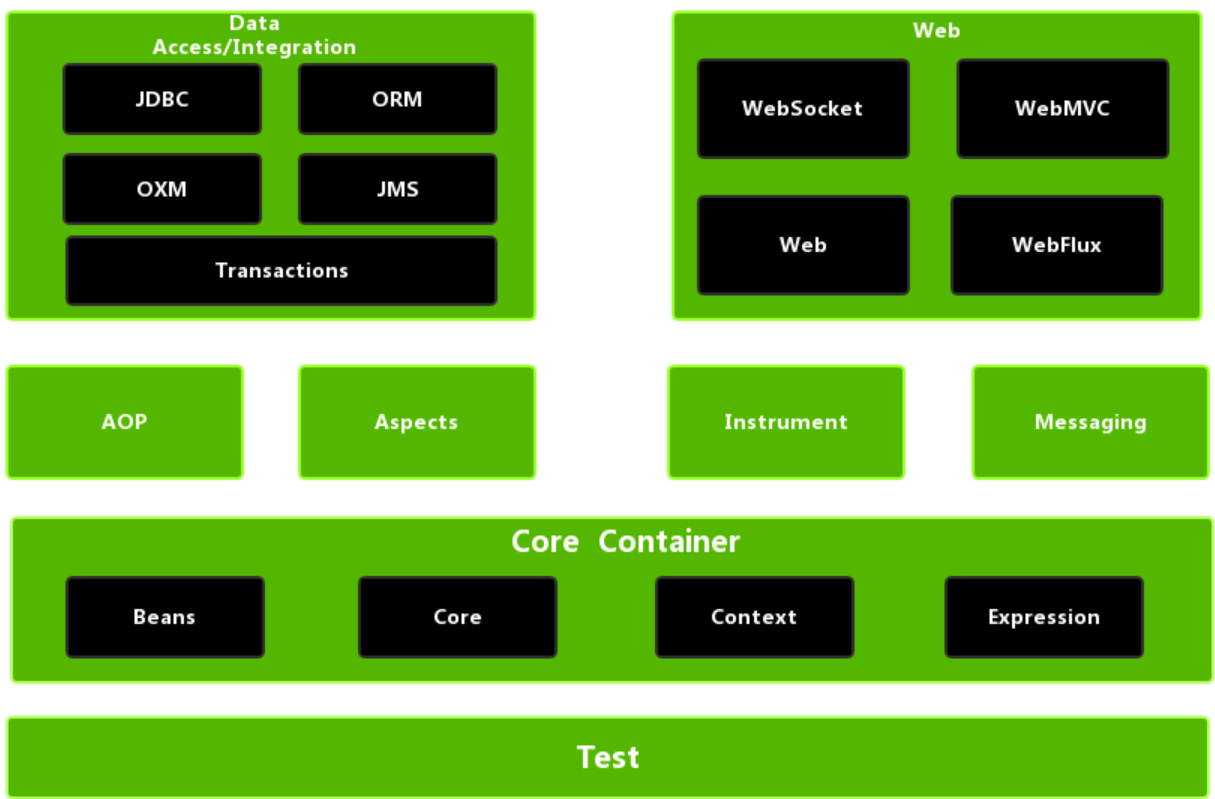
核心容器由 beans、core、context 和 expression(Spring Expression Language,SpEL)4 个模块组成。
- spring-beans 和 spring-core 模块是 Spring 框架的核心模块,包含了控制反转(Inversion of Control,IOC)和依赖注入(Dependency Injection,DI)。BeanFactory 使用控制反转对应用程序的配置和依赖性规范与实际的应用程序代码进行了分离。BeanFactory 属于延时加载,也就是说在实例化容器对象后并不会自动实例化 Bean,只有当 Bean 被使用时,BeanFactory 才会对该 Bean 进行实例化与依赖关系的装配。
- spring-context 模块构架于核心模块之上,扩展了 BeanFactory,为它添加了 Bean 生命周期控制、框架事件体系及资源加载透明化等功能。此外,该模块还提供了许多企业级支持,如邮件访问、远程访问、任务调度等,ApplicationContext 是该模块的核心接口,它的超类是 BeanFactory。与 BeanFactory 不同,ApplicationContext 实例化后会自动对所有的单实例 Bean 进行实例化与依赖关系的装配,使之处于待用状态。
- spring-context-support 模块是对 Spring IoC 容器及 IoC 子容器的扩展支持。
- spring-context-indexer 模块是 Spring 的类管理组件和 Classpath 扫描组件。
- spring-expression 模块是统一表达式语言(EL)的扩展模块,可以查询、管理运行中的对象,同时也可以方便地调用对象方法,以及操作数组、集合等。它的语法类似于传统 EL,但提供了额外的功能,最出色的要数函数调用和简单字符串的模板函数。EL 的特性是基于 Spring 产品的需求而设计的,可以非常方便地同 Spring IoC 进行交互。
# 7.1.1 bean 概述
Spring 就是面向 Bean 的编程(BOP,Bean Oriented Programming),Bean 在 Spring 中处于核心地位。Bean 对于 Spring 的意义就像 Object 对于 OOP 的意义一样,Spring 中没有 Bean 也就没有 Spring 存在的意义。Spring IoC 容器通过配置文件或者注解的方式来管理 bean 对象之间的依赖关系。
spring 中 bean 用于对一个类进行封装。如下面的配置:
<bean id="userService" class="com.itheima.service.impl.UserServiceImpl"> | |
<property name="userDao" ref="userDao"></property> | |
</bean> | |
<bean id="userDao" class="com.itheima.dao.impl.UserDaoImpl"></bean> |
为什么 Bean 如此重要呢?
- spring 将 bean 对象交由一个叫 IOC 容器进行管理。
- bean 对象之间的依赖关系在配置文件中体现,并由 spring 完成。
# 7.3 Spring IOC 相关接口分析
# 7.3.1 BeanFactory 解析
Spring 中 Bean 的创建是典型的工厂模式,这一系列的 Bean 工厂,即 IoC 容器,为开发者管理对象之间的依赖关系提供了很多便利和基础服务,在 Spring 中有许多 IoC 容器的实现供用户选择,其相互关系如下图所示。
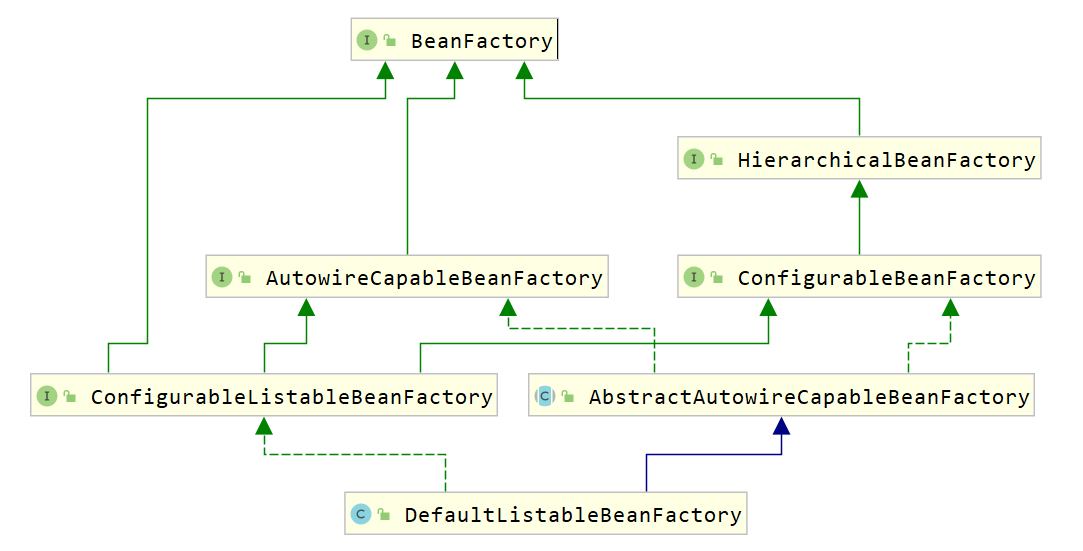
其中,BeanFactory 作为最顶层的一个接口,定义了 IoC 容器的基本功能规范,BeanFactory 有三个重要的子接口:ListableBeanFactory、HierarchicalBeanFactory 和 AutowireCapableBeanFactory。但是从类图中我们可以发现最终的默认实现类是 DefaultListableBeanFactory,它实现了所有的接口。
那么为何要定义这么多层次的接口呢?
每个接口都有它的使用场合,主要是为了区分在 Spring 内部操作过程中对象的传递和转化,对对象的数据访问所做的限制。例如,
- ListableBeanFactory 接口表示这些 Bean 可列表化。
- HierarchicalBeanFactory 表示这些 Bean 是有继承关系的,也就是每个 Bean 可能有父 Bean
- AutowireCapableBeanFactory 接口定义 Bean 的自动装配规则。
这三个接口共同定义了 Bean 的集合、Bean 之间的关系及 Bean 行为。最基本的 IoC 容器接口是 BeanFactory,来看一下它的源码:
public interface BeanFactory { | |
String FACTORY_BEAN_PREFIX = "&"; | |
// 根据 bean 的名称获取 IOC 容器中的的 bean 对象 | |
Object getBean(String name) throws BeansException; | |
// 根据 bean 的名称获取 IOC 容器中的的 bean 对象,并指定获取到的 bean 对象的类型,这样我们使用时就不需要进行类型强转了 | |
<T> T getBean(String name, Class<T> requiredType) throws BeansException; | |
Object getBean(String name, Object... args) throws BeansException; | |
<T> T getBean(Class<T> requiredType) throws BeansException; | |
<T> T getBean(Class<T> requiredType, Object... args) throws BeansException; | |
<T> ObjectProvider<T> getBeanProvider(Class<T> requiredType); | |
<T> ObjectProvider<T> getBeanProvider(ResolvableType requiredType); | |
// 判断容器中是否包含指定名称的 bean 对象 | |
boolean containsBean(String name); | |
// 根据 bean 的名称判断是否是单例 | |
boolean isSingleton(String name) throws NoSuchBeanDefinitionException; | |
boolean isPrototype(String name) throws NoSuchBeanDefinitionException; | |
boolean isTypeMatch(String name, ResolvableType typeToMatch) throws NoSuchBeanDefinitionException; | |
boolean isTypeMatch(String name, Class<?> typeToMatch) throws NoSuchBeanDefinitionException; | |
@Nullable | |
Class<?> getType(String name) throws NoSuchBeanDefinitionException; | |
String[] getAliases(String name); | |
} |
在 BeanFactory 里只对 IoC 容器的基本行为做了定义,根本不关心你的 Bean 是如何定义及怎样加载的。正如我们只关心能从工厂里得到什么产品,不关心工厂是怎么生产这些产品的。
BeanFactory 有一个很重要的子接口,就是 ApplicationContext 接口,该接口主要来规范容器中的 bean 对象是非延时加载,即在创建容器对象的时候就对象 bean 进行初始化,并存储到一个容器中。
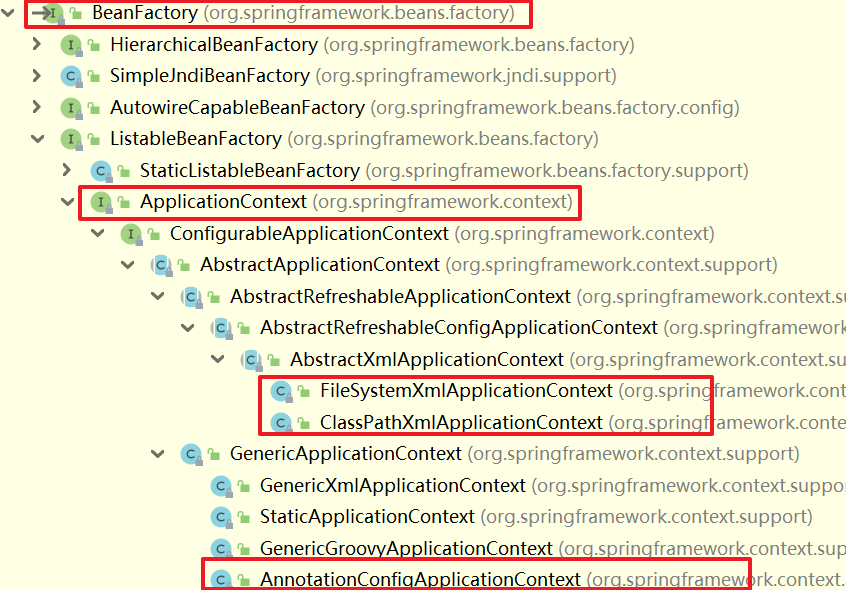
要知道工厂是如何产生对象的,我们需要看具体的 IoC 容器实现,Spring 提供了许多 IoC 容器实现,比如:
- ClasspathXmlApplicationContext : 根据类路径加载 xml 配置文件,并创建 IOC 容器对象。
- FileSystemXmlApplicationContext :根据系统路径加载 xml 配置文件,并创建 IOC 容器对象。
- AnnotationConfigApplicationContext :加载注解类配置,并创建 IOC 容器。
# 7.3.2 BeanDefinition 解析
Spring IoC 容器管理我们定义的各种 Bean 对象及其相互关系,而 Bean 对象在 Spring 实现中是以 BeanDefinition 来描述的,如下面配置文件
<bean id="userDao" class="com.itheima.dao.impl.UserDaoImpl"></bean> | |
bean标签还有很多属性: | |
scope、init-method、destory-method等。 |
其继承体系如下图所示。
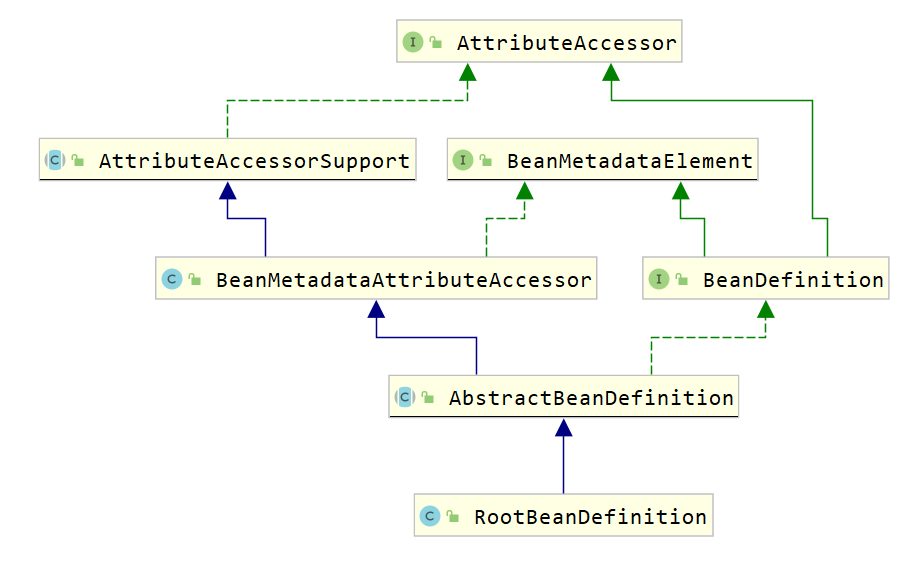
# 7.3.3 BeanDefinitionReader 解析
Bean 的解析过程非常复杂,功能被分得很细,因为这里需要被扩展的地方很多,必须保证足够的灵活性,以应对可能的变化。Bean 的解析主要就是对 Spring 配置文件的解析。这个解析过程主要通过 BeanDefinitionReader 来完成,看看 Spring 中 BeanDefinitionReader 的类结构图,如下图所示。
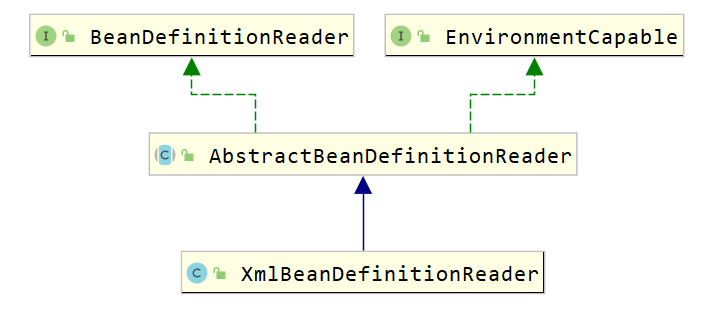
看看 BeanDefinitionReader 接口定义的功能来理解它具体的作用:
public interface BeanDefinitionReader { | |
// 获取 BeanDefinitionRegistry 注册器对象 | |
BeanDefinitionRegistry getRegistry(); | |
@Nullable | |
ResourceLoader getResourceLoader(); | |
@Nullable | |
ClassLoader getBeanClassLoader(); | |
BeanNameGenerator getBeanNameGenerator(); | |
/* | |
下面的 loadBeanDefinitions 都是加载 bean 定义,从指定的资源中 | |
*/ | |
int loadBeanDefinitions(Resource resource) throws BeanDefinitionStoreException; | |
int loadBeanDefinitions(Resource... resources) throws BeanDefinitionStoreException; | |
int loadBeanDefinitions(String location) throws BeanDefinitionStoreException; | |
int loadBeanDefinitions(String... locations) throws BeanDefinitionStoreException; | |
} |
# 7.3.4 BeanDefinitionRegistry 解析
BeanDefinitionReader 用来解析 bean 定义,并封装 BeanDefinition 对象,而我们定义的配置文件中定义了很多 bean 标签,所以就有一个问题,解析的 BeanDefinition 对象存储到哪儿?答案就是 BeanDefinition 的注册中心,而该注册中心顶层接口就是 BeanDefinitionRegistry。
public interface BeanDefinitionRegistry extends AliasRegistry { | |
// 往注册表中注册 bean | |
void registerBeanDefinition(String beanName, BeanDefinition beanDefinition) | |
throws BeanDefinitionStoreException; | |
// 从注册表中删除指定名称的 bean | |
void removeBeanDefinition(String beanName) throws NoSuchBeanDefinitionException; | |
// 获取注册表中指定名称的 bean | |
BeanDefinition getBeanDefinition(String beanName) throws NoSuchBeanDefinitionException; | |
// 判断注册表中是否已经注册了指定名称的 bean | |
boolean containsBeanDefinition(String beanName); | |
// 获取注册表中所有的 bean 的名称 | |
String[] getBeanDefinitionNames(); | |
int getBeanDefinitionCount(); | |
boolean isBeanNameInUse(String beanName); | |
} |
继承结构图如下:

从上面类图可以看到 BeanDefinitionRegistry 接口的子实现类主要有以下几个:
- DefaultListableBeanFactory 在该类中定义了如下代码,就是用来注册 bean
private final Map<String, BeanDefinition> beanDefinitionMap = new ConcurrentHashMap<>(256); |
- SimpleBeanDefinitionRegistry 在该类中定义了如下代码,就是用来注册 bean
private final Map<String, BeanDefinition> beanDefinitionMap = new ConcurrentHashMap<>(64); |
# 7.3.5 创建容器
ClassPathXmlApplicationContext 对 Bean 配置资源的载入是从 refresh()方法开始的。refresh()方法是一个模板方法,规定了 IoC 容器的启动流程,有些逻辑要交给其子类实现。它对 Bean 配置资源进行载入,ClassPathXmlApplicationContext 通过调用其父类 AbstractApplicationContext 的 refresh()方法启动整个 IoC 容器对 Bean 定义的载入过程。
# 7.4 自定义 SpringIOC
现要对下面的配置文件进行解析,并自定义 Spring 框架的 IOC 对涉及到的对象进行管理。
<?xml version="1.0" encoding="UTF-8"?> | |
<beans> | |
<bean id="userService" class="com.itheima.service.impl.UserServiceImpl"> | |
<property name="userDao" ref="userDao"></property> | |
</bean> | |
<bean id="userDao" class="com.itheima.dao.impl.UserDaoImpl"></bean> | |
</beans> |
# 7.4.1 定义 bean 相关的 pojo 类
# 7.4.1.1 PropertyValue 类
用于封装 bean 的属性,体现到上面的配置文件就是封装 bean 标签的子标签 property 标签数据。
public class PropertyValue { | |
private String name; | |
private String ref; | |
private String value; | |
public PropertyValue() { | |
} | |
public PropertyValue(String name, String ref,String value) { | |
this.name = name; | |
this.ref = ref; | |
this.value = value; | |
} | |
public String getName() { | |
return name; | |
} | |
public void setName(String name) { | |
this.name = name; | |
} | |
public String getRef() { | |
return ref; | |
} | |
public void setRef(String ref) { | |
this.ref = ref; | |
} | |
public String getValue() { | |
return value; | |
} | |
public void setValue(String value) { | |
this.value = value; | |
} | |
} |
# 7.4.1.2 MutablePropertyValues 类
一个 bean 标签可以有多个 property 子标签,所以再定义一个 MutablePropertyValues 类,用来存储并管理多个 PropertyValue 对象。
public class MutablePropertyValues implements Iterable<PropertyValue> { | |
private final List<PropertyValue> propertyValueList; | |
public MutablePropertyValues() { | |
this.propertyValueList = new ArrayList<PropertyValue>(); | |
} | |
public MutablePropertyValues(List<PropertyValue> propertyValueList) { | |
this.propertyValueList = (propertyValueList != null ? propertyValueList : new ArrayList<PropertyValue>()); | |
} | |
public PropertyValue[] getPropertyValues() { | |
return this.propertyValueList.toArray(new PropertyValue[0]); | |
} | |
public PropertyValue getPropertyValue(String propertyName) { | |
for (PropertyValue pv : this.propertyValueList) { | |
if (pv.getName().equals(propertyName)) { | |
return pv; | |
} | |
} | |
return null; | |
} | |
@Override | |
public Iterator<PropertyValue> iterator() { | |
return propertyValueList.iterator(); | |
} | |
public boolean isEmpty() { | |
return this.propertyValueList.isEmpty(); | |
} | |
public MutablePropertyValues addPropertyValue(PropertyValue pv) { | |
for (int i = 0; i < this.propertyValueList.size(); i++) { | |
PropertyValue currentPv = this.propertyValueList.get(i); | |
if (currentPv.getName().equals(pv.getName())) { | |
this.propertyValueList.set(i, new PropertyValue(pv.getName(),pv.getRef(), pv.getValue())); | |
return this; | |
} | |
} | |
this.propertyValueList.add(pv); | |
return this; | |
} | |
public boolean contains(String propertyName) { | |
return getPropertyValue(propertyName) != null; | |
} | |
} |
# 7.4.1.3 BeanDefinition 类
BeanDefinition 类用来封装 bean 信息的,主要包含 id(即 bean 对象的名称)、class(需要交由 spring 管理的类的全类名)及子标签 property 数据。
public class BeanDefinition { | |
private String id; | |
private String className; | |
private MutablePropertyValues propertyValues; | |
public BeanDefinition() { | |
propertyValues = new MutablePropertyValues(); | |
} | |
public String getId() { | |
return id; | |
} | |
public void setId(String id) { | |
this.id = id; | |
} | |
public String getClassName() { | |
return className; | |
} | |
public void setClassName(String className) { | |
this.className = className; | |
} | |
public void setPropertyValues(MutablePropertyValues propertyValues) { | |
this.propertyValues = propertyValues; | |
} | |
public MutablePropertyValues getPropertyValues() { | |
return propertyValues; | |
} | |
} |
# 7.4.2 定义注册表相关类
# 7.4.2.1 BeanDefinitionRegistry 接口
BeanDefinitionRegistry 接口定义了注册表的相关操作,定义如下功能:
- 注册 BeanDefinition 对象到注册表中
- 从注册表中删除指定名称的 BeanDefinition 对象
- 根据名称从注册表中获取 BeanDefinition 对象
- 判断注册表中是否包含指定名称的 BeanDefinition 对象
- 获取注册表中 BeanDefinition 对象的个数
- 获取注册表中所有的 BeanDefinition 的名称
public interface BeanDefinitionRegistry { | |
// 注册 BeanDefinition 对象到注册表中 | |
void registerBeanDefinition(String beanName, BeanDefinition beanDefinition); | |
// 从注册表中删除指定名称的 BeanDefinition 对象 | |
void removeBeanDefinition(String beanName) throws Exception; | |
// 根据名称从注册表中获取 BeanDefinition 对象 | |
BeanDefinition getBeanDefinition(String beanName) throws Exception; | |
boolean containsBeanDefinition(String beanName); | |
int getBeanDefinitionCount(); | |
String[] getBeanDefinitionNames(); | |
} |
# 7.4.2.2 SimpleBeanDefinitionRegistry 类
该类实现了 BeanDefinitionRegistry 接口,定义了 Map 集合作为注册表容器。
public class SimpleBeanDefinitionRegistry implements BeanDefinitionRegistry { | |
private Map<String, BeanDefinition> beanDefinitionMap = new HashMap<String, BeanDefinition>(); | |
@Override | |
public void registerBeanDefinition(String beanName, BeanDefinition beanDefinition) { | |
beanDefinitionMap.put(beanName,beanDefinition); | |
} | |
@Override | |
public void removeBeanDefinition(String beanName) throws Exception { | |
beanDefinitionMap.remove(beanName); | |
} | |
@Override | |
public BeanDefinition getBeanDefinition(String beanName) throws Exception { | |
return beanDefinitionMap.get(beanName); | |
} | |
@Override | |
public boolean containsBeanDefinition(String beanName) { | |
return beanDefinitionMap.containsKey(beanName); | |
} | |
@Override | |
public int getBeanDefinitionCount() { | |
return beanDefinitionMap.size(); | |
} | |
@Override | |
public String[] getBeanDefinitionNames() { | |
return beanDefinitionMap.keySet().toArray(new String[1]); | |
} | |
} |
# 7.4.3 定义解析器相关类
# 7.4.3.1 BeanDefinitionReader 接口
BeanDefinitionReader 是用来解析配置文件并在注册表中注册 bean 的信息。定义了两个规范:
- 获取注册表的功能,让外界可以通过该对象获取注册表对象。
- 加载配置文件,并注册 bean 数据。
public interface BeanDefinitionReader { | |
// 获取注册表对象 | |
BeanDefinitionRegistry getRegistry(); | |
// 加载配置文件并在注册表中进行注册 | |
void loadBeanDefinitions(String configLocation) throws Exception; | |
} |
# 7.4.3.2 XmlBeanDefinitionReader 类
XmlBeanDefinitionReader 类是专门用来解析 xml 配置文件的。该类实现 BeanDefinitionReader 接口并实现接口中的两个功能。
public class XmlBeanDefinitionReader implements BeanDefinitionReader { | |
private BeanDefinitionRegistry registry; | |
public XmlBeanDefinitionReader() { | |
this.registry = new SimpleBeanDefinitionRegistry(); | |
} | |
@Override | |
public BeanDefinitionRegistry getRegistry() { | |
return registry; | |
} | |
@Override | |
public void loadBeanDefinitions(String configLocation) throws Exception { | |
InputStream is = this.getClass().getClassLoader().getResourceAsStream(configLocation); | |
SAXReader reader = new SAXReader(); | |
Document document = reader.read(is); | |
Element rootElement = document.getRootElement(); | |
// 解析 bean 标签 | |
parseBean(rootElement); | |
} | |
private void parseBean(Element rootElement) { | |
List<Element> elements = rootElement.elements(); | |
for (Element element : elements) { | |
String id = element.attributeValue("id"); | |
String className = element.attributeValue("class"); | |
BeanDefinition beanDefinition = new BeanDefinition(); | |
beanDefinition.setId(id); | |
beanDefinition.setClassName(className); | |
List<Element> list = element.elements("property"); | |
MutablePropertyValues mutablePropertyValues = new MutablePropertyValues(); | |
for (Element element1 : list) { | |
String name = element1.attributeValue("name"); | |
String ref = element1.attributeValue("ref"); | |
String value = element1.attributeValue("value"); | |
PropertyValue propertyValue = new PropertyValue(name,ref,value); | |
mutablePropertyValues.addPropertyValue(propertyValue); | |
} | |
beanDefinition.setPropertyValues(mutablePropertyValues); | |
registry.registerBeanDefinition(id,beanDefinition); | |
} | |
} | |
} |
# 7.4.4 IOC 容器相关类
# 7.4.4.1 BeanFactory 接口
在该接口中定义 IOC 容器的统一规范即获取 bean 对象。
public interface BeanFactory { | |
// 根据 bean 对象的名称获取 bean 对象 | |
Object getBean(String name) throws Exception; | |
// 根据 bean 对象的名称获取 bean 对象,并进行类型转换 | |
<T> T getBean(String name, Class<? extends T> clazz) throws Exception; | |
} |
# 7.4.4.2 ApplicationContext 接口
该接口的所以的子实现类对 bean 对象的创建都是非延时的,所以在该接口中定义 refresh() 方法,该方法主要完成以下两个功能:
- 加载配置文件。
- 根据注册表中的 BeanDefinition 对象封装的数据进行 bean 对象的创建。
public interface ApplicationContext extends BeanFactory { | |
// 进行配置文件加载并进行对象创建 | |
void refresh() throws IllegalStateException, Exception; | |
} |
# 7.4.4.3 AbstractApplicationContext 类
- 作为 ApplicationContext 接口的子类,所以该类也是非延时加载,所以需要在该类中定义一个 Map 集合,作为 bean 对象存储的容器。
- 声明 BeanDefinitionReader 类型的变量,用来进行 xml 配置文件的解析,符合单一职责原则。BeanDefinitionReader 类型的对象创建交由子类实现,因为只有子类明确到底创建 BeanDefinitionReader 哪儿个子实现类对象。
public abstract class AbstractApplicationContext implements ApplicationContext { | |
protected BeanDefinitionReader beanDefinitionReader; | |
// 用来存储 bean 对象的容器 key 存储的是 bean 的 id 值,value 存储的是 bean 对象 | |
protected Map<String, Object> singletonObjects = new HashMap<String, Object>(); | |
// 存储配置文件的路径 | |
protected String configLocation; | |
public void refresh() throws IllegalStateException, Exception { | |
// 加载 BeanDefinition | |
beanDefinitionReader.loadBeanDefinitions(configLocation); | |
// 初始化 bean | |
finishBeanInitialization(); | |
} | |
//bean 的初始化 | |
private void finishBeanInitialization() throws Exception { | |
BeanDefinitionRegistry registry = beanDefinitionReader.getRegistry(); | |
String[] beanNames = registry.getBeanDefinitionNames(); | |
for (String beanName : beanNames) { | |
BeanDefinition beanDefinition = registry.getBeanDefinition(beanName); | |
getBean(beanName); | |
} | |
} | |
} |
注意:该类 finishBeanInitialization () 方法中调用 getBean () 方法使用到了模板方法模式。
# 7.4.4.4 ClassPathXmlApplicationContext 类
该类主要是加载类路径下的配置文件,并进行 bean 对象的创建,主要完成以下功能:
- 在构造方法中,创建 BeanDefinitionReader 对象。
- 在构造方法中,调用 refresh () 方法,用于进行配置文件加载、创建 bean 对象并存储到容器中。
- 重写父接口中的 getBean () 方法,并实现依赖注入操作。
public class ClassPathXmlApplicationContext extends AbstractApplicationContext{ | |
public ClassPathXmlApplicationContext(String configLocation) { | |
this.configLocation = configLocation; | |
// 构建 XmlBeanDefinitionReader 对象 | |
beanDefinitionReader = new XmlBeanDefinitionReader(); | |
try { | |
this.refresh(); | |
} catch (Exception e) { | |
} | |
} | |
// 根据 bean 的 id 属性值获取 bean 对象 | |
@Override | |
public Object getBean(String name) throws Exception { | |
//return singletonObjects.get(name); | |
Object obj = singletonObjects.get(name); | |
if(obj != null) { | |
return obj; | |
} | |
BeanDefinitionRegistry registry = beanDefinitionReader.getRegistry(); | |
BeanDefinition beanDefinition = registry.getBeanDefinition(name); | |
if(beanDefinition == null) { | |
return null; | |
} | |
String className = beanDefinition.getClassName(); | |
Class<?> clazz = Class.forName(className); | |
Object beanObj = clazz.newInstance(); | |
MutablePropertyValues propertyValues = beanDefinition.getPropertyValues(); | |
for (PropertyValue propertyValue : propertyValues) { | |
String propertyName = propertyValue.getName(); | |
String value = propertyValue.getValue(); | |
String ref = propertyValue.getRef(); | |
if(ref != null && !"".equals(ref)) { | |
Object bean = getBean(ref); | |
String methodName = StringUtils.getSetterMethodNameByFieldName(propertyName); | |
Method[] methods = clazz.getMethods(); | |
for (Method method : methods) { | |
if(method.getName().equals(methodName)) { | |
method.invoke(beanObj,bean); | |
} | |
} | |
} | |
if(value != null && !"".equals(value)) { | |
String methodName = StringUtils.getSetterMethodNameByFieldName(propertyName); | |
Method method = clazz.getMethod(methodName, String.class); | |
method.invoke(beanObj,value); | |
} | |
} | |
singletonObjects.put(name,beanObj); | |
return beanObj; | |
} | |
@Override | |
public <T> T getBean(String name, Class<? extends T> clazz) throws Exception { | |
Object bean = getBean(name); | |
if(bean != null) { | |
return clazz.cast(bean); | |
} | |
return null; | |
} | |
} |
# 7.4.5 自定义 Spring IOC 总结
# 7.4.5.1 使用到的设计模式
- 工厂模式。这个使用工厂模式 + 配置文件的方式。
- 单例模式。Spring IOC 管理的 bean 对象都是单例的,此处的单例不是通过构造器进行单例的控制的,而是 spring 框架对每一个 bean 只创建了一个对象。
- 模板方法模式。AbstractApplicationContext 类中的 finishBeanInitialization () 方法调用了子类的 getBean () 方法,因为 getBean () 的实现和环境息息相关。
- 迭代器模式。对于 MutablePropertyValues 类定义使用到了迭代器模式,因为此类存储并管理 PropertyValue 对象,也属于一个容器,所以给该容器提供一个遍历方式。
spring 框架其实使用到了很多设计模式,如 AOP 使用到了代理模式,选择 JDK 代理或者 CGLIB 代理使用到了策略模式,还有适配器模式,装饰者模式,观察者模式等。
# 7.4.5.2 符合大部分设计原则
# 7.4.5.3 整个设计和 Spring 的设计还是有一定的出入
spring 框架底层是很复杂的,进行了很深入的封装,并对外提供了很好的扩展性。而我们自定义 SpringIOC 有以下几个目的:
- 了解 Spring 底层对对象的大体管理机制。
- 了解设计模式在具体的开发中的使用。
- 以后学习 spring 源码,通过该案例的实现,可以降低 spring 学习的入门成本。